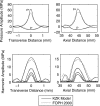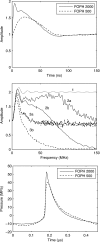Acoustic characterization of high intensity focused ultrasound fields: a combined measurement and modeling approach
- PMID: 19062878
- PMCID: PMC2677345
- DOI: 10.1121/1.2967836
Acoustic characterization of high intensity focused ultrasound fields: a combined measurement and modeling approach
Abstract
Acoustic characterization of high intensity focused ultrasound (HIFU) fields is important both for the accurate prediction of ultrasound induced bioeffects in tissues and for the development of regulatory standards for clinical HIFU devices. In this paper, a method to determine HIFU field parameters at and around the focus is proposed. Nonlinear pressure waveforms were measured and modeled in water and in a tissue-mimicking gel phantom for a 2 MHz transducer with an aperture and focal length of 4.4 cm. Measurements were performed with a fiber optic probe hydrophone at intensity levels up to 24,000 W/cm(2). The inputs to a Khokhlov-Zabolotskaya-Kuznetsov-type numerical model were determined based on experimental low amplitude beam plots. Strongly asymmetric waveforms with peak positive pressures up to 80 MPa and peak negative pressures up to 15 MPa were obtained both numerically and experimentally. Numerical simulations and experimental measurements agreed well; however, when steep shocks were present in the waveform at focal intensity levels higher than 6000 W/cm(2), lower values of the peak positive pressure were observed in the measured waveforms. This underrepresentation was attributed mainly to the limited hydrophone bandwidth of 100 MHz. It is shown that a combination of measurements and modeling is necessary to enable accurate characterization of HIFU fields.
Figures












References
-
- Huber P., Jenne J., Rastert R., Simiantonakis I., Sinn H., Strittmatter H., von Fournier D., Wannenmacher M., and Debus J., “A new noninvasive approach in breast cancer therapy using magnetic resonance imaging-guided focused ultrasound surgery,” Cancer Res. CNREA8 61, 8441–8447 (2001). - PubMed
-
- Illing R., Kennedy J., Wu F., ter Haar G., Protheroe A., Friend P., Gleeson F., Cranston D., Phillips R., and Middleton M., “The safety and feasibility of extracorporeal high-intensity focused ultrasound (HIFU) for the treatment of liver and kidney tumours in a Western population,” Br. J. Cancer BJCAAI10.1038/sj.bjc.6602803 93, 890–895 (2005). - DOI - PMC - PubMed
-
- Hynynen K. and Clement G., “Clinical applications of focused ultrasound—The brain,” Int. J. Hyperthermia IJHYEQ 23, 193–202 (2007). - PubMed
Publication types
MeSH terms
Substances
Grants and funding
LinkOut - more resources
Full Text Sources
Other Literature Sources

